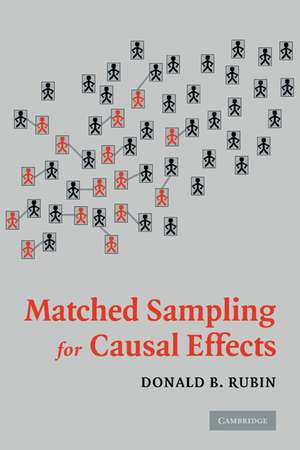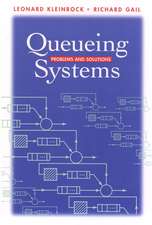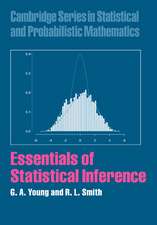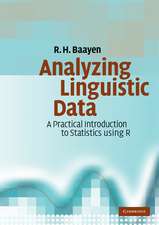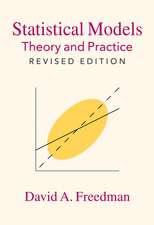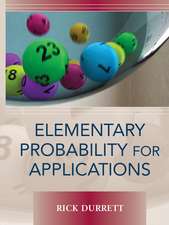Matched Sampling for Causal Effects
Autor Donald B. Rubinen Limba Engleză Paperback – 3 sep 2006
| Toate formatele și edițiile | Preț | Express |
|---|---|---|
| Paperback (1) | 378.83 lei 6-8 săpt. | |
| Cambridge University Press – 3 sep 2006 | 378.83 lei 6-8 săpt. | |
| Hardback (1) | 586.27 lei 6-8 săpt. | +187.41 lei 10-14 zile |
| Cambridge University Press – 3 sep 2006 | 586.27 lei 6-8 săpt. | +187.41 lei 10-14 zile |
Preț: 378.83 lei
Nou
Puncte Express: 568
Preț estimativ în valută:
72.50€ • 75.23$ • 60.60£
72.50€ • 75.23$ • 60.60£
Carte tipărită la comandă
Livrare economică 15-29 martie
Preluare comenzi: 021 569.72.76
Specificații
ISBN-13: 9780521674362
ISBN-10: 0521674360
Pagini: 502
Ilustrații: 108 tables
Dimensiuni: 155 x 235 x 26 mm
Greutate: 0.68 kg
Editura: Cambridge University Press
Colecția Cambridge University Press
Locul publicării:New York, United States
ISBN-10: 0521674360
Pagini: 502
Ilustrații: 108 tables
Dimensiuni: 155 x 235 x 26 mm
Greutate: 0.68 kg
Editura: Cambridge University Press
Colecția Cambridge University Press
Locul publicării:New York, United States
Cuprins
Part I. The Early Years and the Influence of William G. Cochran: 1. William G. Cochran's contributions to the design, analysis, and evaluation of observational studies; 2. Controlling bias in observational studies: a review William G. Cochran; Part II. Univariate Matching Methods and the Dangers of Regression Adjustment: 3. Matching to remove bias in observational studies; 4. The use of matched sampling and regression adjustment to remove bias in observational studies; 5. Assignment to treatment group on the basis of a covariate; Part III. Basic Theory of Multivariate Matching: 6. Multivariate matching methods that are equal percent bias reducing, I: Some examples; 7. Multivariate matching methods that are equal percent bias reducing, II: Maximums on bias reduction for fixed sample sizes; 8. Using multivariate matched sampling and regression adjustment to control bias in observational studies; 9. Bias reduction using Mahalanobis-metric matching; Part IV. Fundamentals of Propensity Score Matching: 10. The central role of the propensity score in observational studies for causal effects Paul R. Rosenbaum; 11. Assessing sensitivity to an unobserved binary covariate in an observational study with binary outcome Paul R. Rosenbaum; 12. Reducing bias in observational studies using subclassification on the propensity score Paul R. Rosenbaum; 13. Constructing a control group using multivariate matched sampling methods that incorporate the propensity score Paul Rosenbaum; 14. The bias due to incomplete matching Paul R. Rosenbaum; Part V: Affinely Invariant Matching Methods with Ellipsoidally Symmetric Distributions, Theory and Methodology: 15. Affinely invariant matching methods with ellipsoidal distributions Neal Thomas; 16. Characterizing the effect of matching using linear propensity score methods with normal distributions Neal Thomas; 17. Matching using estimated propensity scores: relating theory to practice Neal Thomas; 18. Combining propensity score matching with additional adjustments for prognostic covariates; Part VI. Some Applied Contributions: 19. Causal inference in retrospective studies Paul Holland; 20. The design of the New York school choice scholarships program evaluation Jennifer Hill and Neal Thomas; 21. Estimating and using propensity scores with partially missing data Ralph D'Agostino Jr.; 22. Using propensity scores to help design observational studies: application to the tobacco litigation; Part VII. Some Focused Applications: 23. Criminality, aggression and intelligence in XYY and XXY men H. A. Witkin; 24. Practical implications of modes of statistical inference for causal effects and the critical role of the assignment mechanism; 25. In utero exposure to phenobarbital and intelligence deficits in adult men June Reinisch, Stephanie Sanders, and Erik Mortensen; 26. Estimating causal effects from large data sets using propensity scores; 27. On estimating the causal effects of DNR orders Martin McIntosh.
Recenzii
'The book provides an accessible introduction to the study of matched sampling and as such it is well addressed to students and researchers in statistics, epidemiology, medicine, economics, education, sociology, political science, and anyone doing empirical research to evaluate the causal effects of interventions.' Zentralblatt MATH
Notă biografică
Descriere
This selection of Donald B. Rubin's contributions to matched sampling includes classic theoretical studies and real applications.
